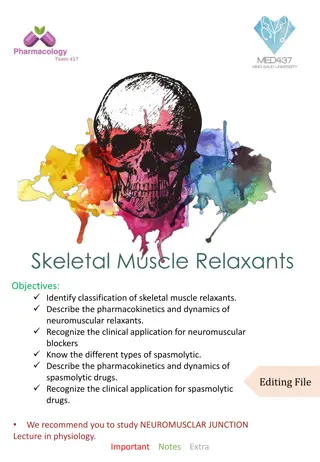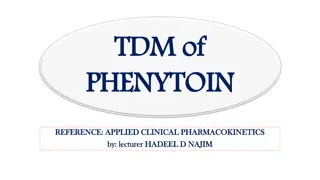Understanding Pharmacokinetics in Clinical Pharmacology
Pharmacokinetics, as explained in a lecture by Oula Mohammed Sami, M.B.Ch.B/MSc in clinical pharmacology, delves into how the body processes drugs, contrasting with pharmacodynamics which focuses on drug actions. Key topics covered include properties influencing treatment outcomes, the significance of studying pharmacokinetics, and the ADME (Absorption, Distribution, Metabolism, Elimination) process. Routes of drug administration and the importance of absorption, distribution, metabolism, and elimination in pharmacokinetic properties are highlighted in this informative session.
Download Presentation

Please find below an Image/Link to download the presentation.
The content on the website is provided AS IS for your information and personal use only. It may not be sold, licensed, or shared on other websites without obtaining consent from the author. Download presentation by click this link. If you encounter any issues during the download, it is possible that the publisher has removed the file from their server.
E N D
Presentation Transcript
Pharmacokinetics Lec-1 Presented by Oula Mohammed Sami M.B.Ch.B/ MSc. Clinical pharmacology
Paracetamolis known as acetaminophenwhich is commonly known by the brand name paracetol , Panadol .
Pharmacokineticsrefers to what the body does to a drug, whereas pharmacodynamics describes what the drug does to the body.
Pharmacokinetics refers to what the body does to a drug, whereas describes what the drug does to the body (Chapter 2). pharmacodynamics Four pharmacokinetic properties determine the onset, intensity, route of administration, dose, frequency, and duration of treatment.
Why we study the pharmacokinetics??? Frequency Duration Routs Dose onset Intensity
Pharmacokinetic Pharmacokinetic properties properties Absorption: from the site of administration into plasma. ADME ADME Distribution: the interstitial and intracellular fluids. Metabolism: by the liver or other tissues. Elimination: in urine, bile, or feces.
Pharmacokinetic properties (ADME) Absorption: from the site of administration into plasma. Distribution: the drug leaves the blood stream & distribute into the interstitial and intracellular fluids. Metabolism: the drug may be biotransformed through metabolism by the liver or other tissues. Elimination: the drug & its metabolites are eliminated from the body in urine, bile, or feces.
Routes of Drug Administration (to be discussed later in the practical lab ) 1.Absorption Absorption is the transfer of a drug from (the site of administration the bloodstream. The rate and extent of absorption depend on the environment where the drug is absorbed, chemical properties of the drug, and the route of administration (which influences bioavailability). Routes of administration other than intravenous may result in partial absorption and lower bioavailability.
The rate and extent of absorption The rate and extent of absorption
IV injection delivers the drug directly to the blood completely absorbed 100% bioavailability Other routes partial absorption and lower bioavailability.
An 18-year-old female patient is brought to the emergency department due to drug overdose. Which of the following routes of administration is the most desirable for administering the antidote for the drug overdose? A. Intramuscular B. Intravenous C. Oral D. Subcutaneous E. Transdermal
Passive diffusion 99% drugs are absorbed by this mechanism ,the drug moves from high conc. to low conc. It does not involve a carrier , no energy is required & is not saturable , shows low structural specificity . Water-soluble drugs penetrate through aqueous channels, whereas lipid-soluble drugs readily move across the membrane lipid bilayers.
Facilitated diffusion Drugs can enter the cell through transmembrane carrier proteins that facilitate the passage of such large molecules. Carrier proteins undergo conformational changes, allowing the passage of drugs or endogenous molecules into the interior of cells. It does not require energy, can be saturated, and may be inhibited by compounds that compete for the carrier.
Active transport It also involves specific carrier proteins. However, it is energy dependent , driven by the hydrolysis of adenosine triphosphate (ATP)..It is capable of moving drugs against a concentration gradient, from a region of low drug concentration to one of higher concentration. The process is saturable. Active transport systems are selective Active transport systems and may be inhibited by other compounds.
Endocytosis and exocytosis Endocytosisis used to transport drugs of large size across the cell membrane. It involves engulfment of a drug by the cell membrane and transport into the cell by pinching off the drug-filled vesicle. Exocytosis endocytosis.Vitamin B12 is transported by endocytosis, whereas neurotransmitters (norepinephrine) are released from the nerve terminal by exocytosis. is the reverse of
Factors influencing absorption P _B A T_ P Surface area P- Blood flow Ph Time glycoprotein
1. Effect of pH on drug absorption Lipid solubility Ionization pKa of drug and PH of media
Most drugs are either weak acids or weak bases. A drug passes through membranes more readily if it is uncharged Thus, for a weak acid, the uncharged, protonated HA can permeate through membranes, and A cannot. For a weak base, the uncharged form B penetrates through the cell membrane, but the protonated form BH+ does not. Therefore, the effective concentration of the permeable form of each drug at its absorption site is determined by the relative concentrations of the charged and uncharged forms. The ratio between the two forms is, in turn, determined by the pH at the site of absorption and by the strength of the weak acid or base, which is represented by the ionization constant, pKa . The lower the pKa of a drug, the more acidic it is. Conversely, the higher the pKa , the more basic is the drug.
Solubility : lipid soluble drug cross easily through the cell membrane(diffuse into lipid bilayers).Water soluble drug cannot cross the lipid membrane. Ionization : (Non ionized = non polar = non charged drug = Lipid soluble) crossthe membrane.(Ionized = polar = charged) drug has a charge attract water (water shell) become as water soluble not cross the membrane. Ionization depends on pKa of the drug and PH of the media. ( for a drug to be absorbed it must be of the same nature to the media of absorption ) e.g. acidic drug in basic environment ionized not cross , also basic drug in acidic environment ionized not cross .
pKa : is the PH at which half of the drug is in its ionized form and half isn t ( 50% ionized : not absorbed & 50 % non-ionized : absorbed ) , a neutral point , the ionization constant. E.g aspirin (acetylsalicylic acid) pKa = 3.5. So aspirin is an acidic drug , in the stomach (PH=1.5) (99 % absorbed). While aspirin in the small intestine( PH=8.5) (1 % absorbed) . Therefore aspirin in PH media lower than 3.5 absorption , while in PH more than 3.5 even if acidic such as (4 , 5, 6) absorption. That is why aspirin mainly affect gastric mucosa (peptic ulcer) absorption is in acidic PH=1.5
Drug A is a weakly basic drug with a pKa of 7.8. If administered orally, at which of the following sites of absorption will the drug be able to readily pass through the membrane? A. Mouth (pH approximately 7.0) B. B. Stomach (pH of 2.5) C. C. Duodenum (pH approximately 6.1) D. D. Jejunum (pH approximately 8.0) E. E. Ileum (pH approximately 7.0)
2. Blood flow The intestinesreceive much more blood flow than does the stomach, so absorption from the intestine is more. [Note: Shock severely reduces blood flow to cutaneous tissues, thereby minimizing absorption from SC administration.]
3. Total surface area available for absorption The intestinehas a surface area about 1000-fold that of the stomach, making absorption of the drug across the intestine more efficient.
4. Contact time not well absorbed absorbed slowly
4. Contact time In severe diarrhea, a drug moves through the GI tract very quickly not well absorbed. Conversely, the presence of food in the stomach dilutes the drug and slows gastric emptying absorbed slowly.
5. Expression of P-glycoprotein P-glycoprotein is a transmembrane transporter protein responsible for transporting various molecules, including drugs, from tissues to blood. It is expressed in the liver, kidneys, placenta, intestines, and brain capillaries.
5- P-glycoprotein responsible for transporting various molecules, including drugs, from tissues to blood. It is expressed in the liver, kidneys, placenta, intestines, and brain capillaries. It is involved in transportation of drugs from tissues to blood. That is, it pumps drugs out of cells. Thus, in areas of high expression, P-glycoprotein reduces drug absorption. It is also associated with multidrug resistance. is a transmembrane transporter protein
P-glycoprotein drug absorption Multidrug resistance























